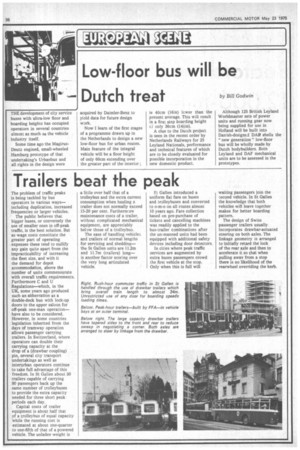Trailers beat the peak
Page 40

If you've noticed an error in this article please click here to report it so we can fix it.
The problem of traffic peaks is being tackled by bus operators in various ways— including duplication, increased frequencies or larger vehicles.
The public believes that bigger buses, or conversely the use of smaller ones in off-peak traffic, is 'the best solution. But as wage costs constitute the greater part of operating expenses these tend to nullify any gain quite apart from the impracticability of increasing the fleet size, and with it the demand for depot accommodation, above the number of units commensurate with overall traffic requirements. Furthermore C and U Regulations—which, in 'the UK, some years ago produced such an abberration as a double-deck bus with lock-up doors to the upper saloon for off-peak one-man operation— have also to be considered. However, in some countries legislation inherited from the days of tramway operation allows passenger carrying trailers. In Switzerland, where operators can double their carrying capacity at the drop of a (drawbar coupling) pin, several city transport undertakings as well as interurban operators continue to take full advantage of this freedom. In St Gallen about 30 trailers capable of carrying 90 passengers back up the same number of trolleybuses to provide the extra capacity needed for three short peak periods each day.
Capital costs of trailer equipment is about half that of a trolleybus of equal capacity while the running cost is estimated at about one-quarter to one-fifth of that of a powered vehicle. The unladen weight is a little over half that of a trolleybus and the extra current consumption when hauling a trailer does not normally exceed 15-20 per cent. Furthermore maintenance costs of a trailer, without complicated mechanical equipment, are appreciably below those of a trolleybus.
The ease of handling vehicle:, and trailers of normal lengths for servicing and shedding— 'the St Gallen units are 11.2m and 11.7m (trailers) long— is another factor scoring over the very long articulated vehicle.
St Gallen introduced a uniform flat fare on buses and trolleybuses and converted to o-m-o on all routes almost 10 years ago. Fare collection based on pre-purchase of tickets and cancelling machines was readily applied to the bus-trailer combinations after the un-manned units had been equipped with additional safety devices including door detectors.
In cities where peak traffic services are augmented by extra buses passengers crowd the first vehicle at the stop. Only when this is full will waiting passengers join the second vehicle. In St Gallen the knowledge that both vehicles will leave together makes for better boarding pattern.
The design of Swiss passenger trailers usually Incorporates drawbar-actuated steering on both axles. The linkage geometry is arranged to initially retard the lock of the rear axle and then to accelerate it so that when pulling away from a stop there is no likelihood of the rearwheel overriding the kerb.






























































































